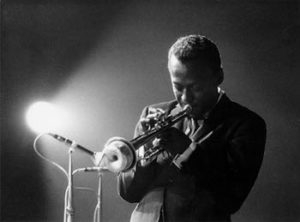
Miles Davis
Miles Davis was born on this date in 1926. He was a Black trumpet player and bandleader, one of the most innovative, influential, and respected figures in the history of jazz.
Born in Alton, IL, Davis began music lessons after his father gave him a trumpet on his 13th birthday. Two years later, he joined the Musicians' Union and began playing with a local band on weekends. At that time, he met trumpeter Clark Terry, who encouraged him. 1944, after graduating from high school, he went to New York City to study classical music at the Julliard School of Music. While there, he also began playing with alto saxophonist Charlie Parker, trumpeter Dizzy Gillespie, and other pioneers of the (then) new jazz style known as bebop.
In 1945, at 19, he began playing in a combo led by Parker. Earning a contract with Capitol Records, the band went into the studio in January 1949 for the first of three sessions that profoundly influenced the development of the cool jazz style on the West Coast. In February 1957, Capitol finally issued the tracks on an LP called “Birth of the Cool.” Davis, meanwhile, had moved on to co-leading a band with pianist Tadd Dameron in 1949, but the trumpeter's progress was impeded by an addiction to heroin that plagued him in the early 1950s.
His performances and recordings became more haphazard, but in January 1951, he began a long series of recordings for the Prestige label that became his main recording outlet for the next several years. He managed to kick his habit by the middle of the decade, and he made a strong impression playing “Round Midnight" at the Newport Jazz Festival in July 1955. This performance led major label Columbia Records to sign him. The prestigious contract allowed him to put together a permanent band, and he organized a quintet that began recording his Columbia debut, “Round About Midnight,” in October. The quintet featured saxophonist John Coltrane, pianist Red Garland, bassist Paul Chambers, and drummer Philly Joe Jones.
He had the remaining five albums on his Prestige contract, however. Over the next year, he was forced to alternate his Columbia sessions with sessions for Prestige to fulfill this previous commitment. The latter resulted in the Prestige albums “The New Miles Davis Quintet,” “Cookin', Workin', Relaxin', and Steamin',” making Davis' first quintet one of his better-documented outfits. 1957 Davis teamed with arranger Gil Evans for his second Columbia LP, “Miles Ahead.” Miles played flugelhorn, the album, released in 1958, was later inducted into the Grammy Hall of Fame, intended to honor recordings made before the Grammy Awards were instituted in 1959. In December of that year, Davis returned to Paris, adding saxophonist Cannonball Adderley to his group, creating the Miles Davis Sextet, which recorded the album “Milestones” in 1958.
That July, Davis again collaborated with Gil Evans and an orchestra on an album of music from “Porgy and Bess.” Davis began to experiment in the sextet, basing his improvisations on scales rather than chord changes. This led to his next band recording, “Kind of Blue,” in 1959, an album that became a landmark in modern jazz and the most popular disc of Davis' career, eventually selling over two million copies, a phenomenal success for a jazz record. In sessions held in November of that year and March 1960, Davis again followed his pattern of alternating band releases and collaborations with Gil Evans, recording “Sketches of Spain,” containing traditional Spanish music and original compositions in that style. By the time he returned to the studio to make his next band album in March 1961, Coltrane was guest on a couple of tracks called “Someday My Prince Will Come.” The Davis quintet’s next recording preceded the two-LP set “Miles Davis in Person” (Friday & Saturday Nights at the Blackhawk, San Francisco).
In the spring of 1963, “Seven Steps to Heaven” was recorded with an entirely new lineup. The sessions included Herbie Hancock, Ron Carter, and Tony Williams. It was another pop chart entry that earned Grammy nominations for both Best Instrumental Jazz Performance by a Soloist or Small Group and Best Instrumental Jazz Performance by a Large Group. By 1964, the final member of the classic Miles Davis Quintet of the 1960s was in place with the addition of saxophonist Wayne Shorter to the team of Davis, Carter, Hancock, and Williams. While continuing to play standards in concert, this unit embarked on a series of albums of original compositions: “Sorcerer,” “Nefertiti,” “Miles in the Sky,” and “Filles de Kilimanjaro.”
But Hancock, pianist Joe Zawinul, and guitarist John McLaughlin participated on Davis' next album, “In a Silent Way,” in 1969. With his next album, “Bitches Brew,” Davis turned more overtly to a jazz-rock style. He followed it with “Miles Davis at Fillmore East,” “Jack Johnson,” “Live-Evil,” “On the Corner,” and “In Concert,” all in 1971. In October 1972, Davis broke his ankles in a car accident and became less active. In 1975, he gave up recording entirely due to illness, undergoing surgery for hip replacement later in the year. Five years passed before he returned to action by recording “The Man with the Horn” in 1980 and going back to touring in 1981. By now, he was an elder statesman of jazz.
Those who supported his eclectic approach had incorporated jazz and his innovations into the music. He was also a celebrity whose appeal extended far beyond the basic jazz audience. In 1990, Davis performed a leading role as a jazz musician in the Australian motion picture “Dingo” in 1991.
Miles Davis died on September 28, 1991. He was a leading figure in the bebop style of jazz and in combining jazz and rock music. His album “Doo-Bop,” released the year after his death in 1999, was one of the first to fuse jazz with hip-hop and rap music styles.
Jazz People
by Harry N. Abrams, Incorporated, New York
Copyright 1976
ISBN 0-8109-1152-3
Image by Jeff Sedik